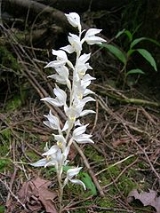
Cephalanthera austiniae
Encyclopedia
Cephalanthera austiniae is a species of orchid
known by the common names phantom orchid and snow orchid because the entire plant is white. Native to the western United States and Canada, it is the only species of genus Cephalanthera
found outside of Europe and Asia, and the only one entirely dependent on symbiotic mycorrhizae
for its nutrition. This mycoheterotrophic
orchid has no chlorophyll
, so it makes no energy for itself. It is a distinctive plant, rising from the dark, moist forest floor on waxy white stems and bearing orchid blossoms which are white or yellowish with yellow centers. Its leaves, if present, are rudimentary since such structures are not needed for collecting sunlight. The plant is becoming more scarce as its habitat, dense, isolated forest, becomes more rare.
Orchidaceae
The Orchidaceae, commonly referred to as the orchid family, is a morphologically diverse and widespread family of monocots in the order Asparagales. Along with the Asteraceae, it is one of the two largest families of flowering plants, with between 21,950 and 26,049 currently accepted species,...
known by the common names phantom orchid and snow orchid because the entire plant is white. Native to the western United States and Canada, it is the only species of genus Cephalanthera
Cephalanthera
Cephalanthera , abbreviated Ceph in horticultural trade, is a genus of mostly terrestrial orchids. Members of this genus have rhizomes rather than tubers. About 15 species are currently recognised, several of them common in Europe, for example the Sword-leaved Helleborine C. longifolia...
found outside of Europe and Asia, and the only one entirely dependent on symbiotic mycorrhizae
Mycorrhiza
A mycorrhiza is a symbiotic association between a fungus and the roots of a vascular plant....
for its nutrition. This mycoheterotrophic
Myco-heterotrophy
Myco-heterotrophy is a symbiotic relationship between certain kinds of plants and fungi, in which the plant gets all or part of its food from parasitism upon fungi rather than from photosynthesis. A myco-heterotroph is the parasitic plant partner in this relationship...
orchid has no chlorophyll
Chlorophyll
Chlorophyll is a green pigment found in almost all plants, algae, and cyanobacteria. Its name is derived from the Greek words χλωρος, chloros and φύλλον, phyllon . Chlorophyll is an extremely important biomolecule, critical in photosynthesis, which allows plants to obtain energy from light...
, so it makes no energy for itself. It is a distinctive plant, rising from the dark, moist forest floor on waxy white stems and bearing orchid blossoms which are white or yellowish with yellow centers. Its leaves, if present, are rudimentary since such structures are not needed for collecting sunlight. The plant is becoming more scarce as its habitat, dense, isolated forest, becomes more rare.

